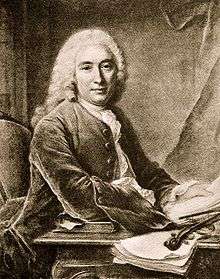Issé (opera)
Issé is an operatic pastorale héroïque by the French composer André Cardinal Destouches. Initially it was in three acts. The definitive revised version consists of a prologue and five acts.[1] The libretto was by Antoine Houdar de La Motte.[2] Although Destouches was only 25 at the time of its premiere, it is considered his best score.[3]
| André Cardinal Destouches |
|---|
 |
|
Stage music
|
Performance history
Issé was first performed in a concert version without a prologue in the Salle de la Belle-Cheminée at the Palace of Fontainebleau on 7 October 1697.[2][4] At the request of Louis XIV, a prologue was added for the official premiere, a concert performance on 17 December at the Trianon (Versailles) for the festivities surrounding the marriage of Princess Marie Adélaïde of Savoy to Louis' grandson, the Duke of Burgundy, to whom Issé was dedicated.[5] Louis XIV was so pleased with the work after its performance at the Trianon, that he gave Destouches a purse containing 200 louis. The first full staging by the Paris Opera (with the prologue and three acts) was on 30 December 1697 at the Théâtre du Palais-Royal in Paris.[6] Destouches revised it in a grander five-act form for its revival at the Palais-Royal on 14 October 1708.[3] Issé was so successful, it remained in the repertory there until 1757. It was also given again a number of times at the court up to 1773. Madame de Pompadour sang the title role for a production in the Théâtre des Petits Cabinets at the Palace of Versailles in 1749.[2]
Roles
| Role | Voice type | Fontainebleau cast,[4] 7 October 1697 (Conductor: Antoine Grimaldi) |
Trianon cast,[7] 17 December 1697 (Conductor: Antoine Grimaldi) |
Five-act version,[1][8] 14 October 1708 (Conductor: – ) |
|---|---|---|---|---|
| Prologue | ||||
| The first Hespéride | soprano | – | Marie-Louise Desmatins | Mlle Dun |
| Hercule | baritone | – | Charles Hardouin | Gabriel-Vincent Thévenard |
| Jupiter | baritone | – | Gabriel-Vincent Thévenard | Charles Hardouin |
| Pastorale héroique | ||||
| Issé | soprano | Marthe Le Rochois | Marthe Le Rochois | Françoise Journet |
| Doris | soprano | Fanchon Moreau | Fanchon Moreau | Mlle Poussin |
| Philémon (Apollon) | haute-contre | Louis Gaulard Dumesny | Louis Gaulard Dumesny | Jacques Cochereau |
| Grand priest | baritone | Charles Hardouin | Charles Hardouin | Charles Hardouin |
| Hylas | baritone | Gabriel-Vincent Thévenard | Gabriel-Vincent Thévenard | Gabriel-Vincent Thévenard |
| Pan | bass | Jean Dun, 'père' | Jean Dun, 'père' | Jean Dun, 'père' |
| Shepherd, oracle | haute-contre | Jean Boutelou | Jean Boutelou | Jean Boutelou |
| Sleep | haute-contre | Jean Boutelou | Jean Boutelou | Buseau |
Synopsis
Apollon (Apollo), disguised as a shepherd called Philémon, pursues the nymph Issé, while Pan takes an interest in Doris.
Discography
Judith van Wanroij, Issé, Chantal Santon-Jeffery, Doris, Eugénie Lefebvre, (La première Hespéride, une Nymphe, une Dryade), Mathias Vidal, Apollon (sous les traits du berger Philémon), Thomas Dolié, Hylas, Matthieu Lécroart, Jupiter, Pan, Etienne Bazola, Hercule, le Grand Prêtre, Stéphen Collardelle, un Berger, (Sommeil, Oracle), Les Chantres du Centre de Musique Baroque de Versailles, Ensemble Les Surprises, conducted by Louis-Noël Bestion de Camboulas. 2 CD Ambronay éditions 2019
References
Notes
- Casaglia, Amadeus Almanac (Issé, 14 October 1708), accessed 15 June 2013.
- Wood 1992.
- Pitou, vol. 1, pp. 241–242.
- Casaglia, Amadeus Almanac (Issé, 7 October 1697), accessed 5 November 2009.
- Wood 1992; Brenac, Issé. Casaglia places this performance at the "Théâtre de la Cour de Marbre du Grand Trianon di Versailles". This is confusing, since what is usually referred to as the Cour de Marbre is located in the main palace at Versailles (see Appartement du roi).
- Pitou, vol. 1, pp. 241–242; Wood 1992; Casaglia, Amadeus Almanac (Issé, 30 December 1697), accessed 16 June 2013. The cast was the same as on 17 December.
- Casaglia, Amadeus Almanac (Issé, 17 December 1697), accessed 15 June 2013.
- Brenac, Issé.
Sources
- Brenac, Jean-Claude. Le magazine de l'opéra baroque
- Casaglia, Gherardo. Amadeus Almanac
- Pitou, Spire (1983–1990). The Paris Opéra: An Encyclopedia of Operas, Ballets, Composers, and Performers (3 volumes). Westport, Connecticut: Greenwood Press. ISBN 978-0-686-46036-7.
- Wood, Caroline (1992), Issé, vol. 2, p. 833, in The New Grove Dictionary of Opera, ed. Stanley Sadie (London) ISBN 0-333-73432-7